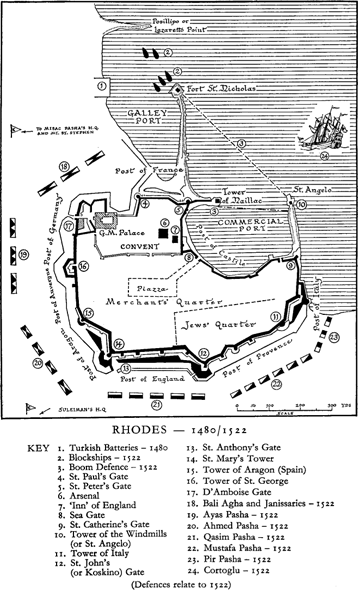Shadow of God (75 page)
Authors: Anthony Goodman

sappers.
(e) Soldiers employed in building trenches and fortifications.
Selim.
Father of Suleiman. Known as “
Yavuz
,” (the Grim), as well as “Protector of the Faithful.”
Seneschal.
(me) Officer in charge of domestic arrangements, justice, and ceremony.
serai.
(t) House or dwelling place (tent, pavilion, etc).
Seraskier.
(t) A Commander-in-Chief.
Sheik-ul-Islam.
(a) “Ancient of Islam.” The Mufti of Istanbul and the leader and authority of the Muslim community.
Sheitan.
(a) From “Ash-Shaytan.” Satan, the devil.
Shiite.
(a) Member of the Shiite movement of Islam, which considers Mohammed’s true successor to be Ali, the Fourth Caliph, and cousin of the Prophet.
Sipahi. (or spahi)
(t) Calvary soldier. Can be either permanent professional cavalry or feudal cavalry.
Sultan Valideh.
(t) The current Queen Mother.
tu ra.
ra.
(t) Official seal of the Sultan, affixed to any official decree, and confirming its authenticity.
Turcopilier.
(t) Commander-in-Chief of the light cavalry.
Vizier.
(a) High official in a Muslim country; minister of state.
See
Grand Vizier
.
yarak.
(t) In fine condition. Physically fit.
yeni cheri.
(t) Literally, “young soldier.” Later Anglicized to “Janissary.”

Abdalati, H.
Islam in Focus.
Islamic Teaching Center, 1975.
Angel, M.D.
The Jews of Rhodes.
New York: Sepher-Hermon Press, 1978.
Atil E., ed.
Turkish Art.
Washington, D.C.: Smithsonian Press, 1980.
Atil, E.
The Age of Süleyman the Magnificent
. New York: Abrams, 1987.
Bradford, Ernle.
The Shield and the Sword.
New York: Dutton, 1973.
Foster, C.T. and Daniell, FHB.
Life and Letters of Ogier Ghiselin de
Busbecq
. Vol I. London: C. Kegan Paul & Co., 1881.
Foster, E.S.
The Turkish Letters of Oghier Ghiselin de Busbecq, Imperial
Ambassador at Constantinople 1554-1562.
Oxford, 1968.
Friedenwald, H.
The Jews and Medicine
. 2 Volumes. Baltimore: Johns Hopkins Press, 1994.
Gordon, B.L.
Medieval and Renaissance Medicine.
New York: Philosophical Library, 1959.
Guilmartin, Jr., J.F.
Gunpowder and Galleys.
Cambridge: Cambridge University Press, 1974.
Halman, T.S.
Süleyman the Magnificent Poet
. Istanbul: Dost Publications, 1987.
Heyd, Uriel.
Moses Hamon, Chief Jewish Physician to Sultan Süleyman the
Magnificent.
Oriens. Vol. 16. pp. 152-170. Dec. 31, 1963.
Irving, T.B. (translator)
The Qur’an.
Brattleboro: Amana Books, 1985.
Kunt, M. & Woodhead, C.
Süleyman the Magnificent and His Age.
London: Longman, 1995.
Mansel, P.
Constantinople.
New York: St. Martin’s Press, 1996.
McCarthy, J.
The Ottoman Turks
. London: Longman, 1997.
Meijer, F.
A History of Seafaring in the Classical World.
New York
:
St. Martin’s Press, 1986.
Merriman, Roger Bigelow,
Suleiman the Magnificent.
Harvard: Cambridge, 1944.
Pallis, A.
In the Days of the Janissaries
. Hutchenson & Co, 1951.
Phipps, W.E.
Muhammad and Jesus.
Continuum, New York: Phipps
,
1995.
Porter, R.
The Greatest Benefit to Mankind.
New York: WW Norton & Co, 1997.
Riley-Smith, Jonathan, Ed.
Oxford Illustrated History of the Crusades.
Oxford: Oxford Press, 1995.
Shaw, Stanford J.
History of the Ottoman Empire and Modern Turkey.
Volume I. York: Cambridge University Press, 1976.
Shaw, Stanford J.
The Jews of the Ottoman Empire and the Turkish
Republic.
New York: New York University Press, 1991.
Sherif, F.
A Guide to the Contents of the Qur’an
. London: Ithaca Press, 1985.
Sire, H.J.A.
The Knights of Malta.
New Haven: Yale University Press, 1994.
Wheatcroft, Andrew.
The Ottomans.
New York: Viking, 1993.



The idea for this book was conceived in August of 1982 as I stood on the battlements of Rhodes and watched the sound and light show with my daughter, Katie. My special thanks to her and my family for listening to me ramble through the ideas for a story as the next two decades slipped by, buried in research and musings.
I want to thank Jerry Gross, the Editor’s Editor, for his invaluable help in shaping and refining my writing, as well as playing the roles of father and advisor.
And thank you to Hillel Black, Executive Editor at Sourcebooks, who also stood on the battlements of Rhodes with
his
son eighteen years later, and listened to the same story of Suleiman and the Knights of St. John; who read the original manuscript and was able to see a book in there somewhere. I am grateful for his editing and his private tutorial on writing.
To Peter Lynch at Sourcebooks for his editing skills and patience; and to Taylor Poole for allowing me to participate in the overall artistic design. Finally, to Judith Kelly, Maggy Tinucci, Sean Murray, Jeff Tegge, Todd Stocke, Jon Malysiak, and Jennifer Fusco.

Anthony A. Goodman is an adjunct Professor of Medicine at Montana State University.
The Shadow of God
, his first novel, was inspired by a visit to Rhodes, where he became fascinated by the conflict that engulfed the three great monotheisms five hundred years ago. He lives in Bozeman, Montana.
